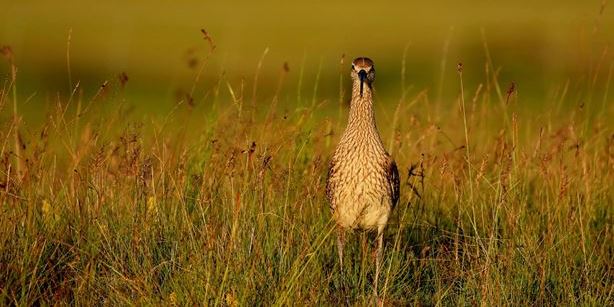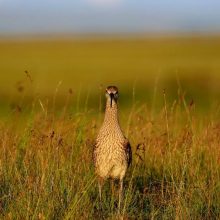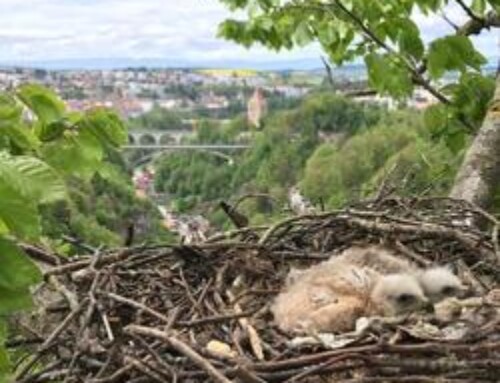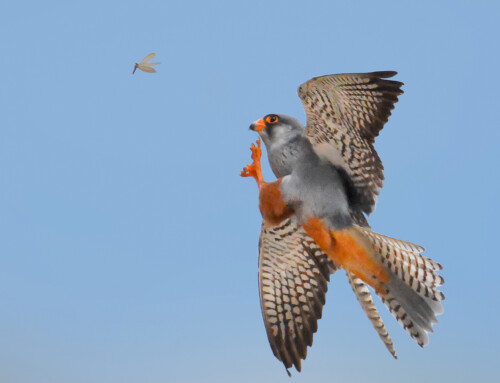The non-stop migrations of Whimbrels between Iceland and West Africa
LINKED PAPER
Very rapid long-distance sea crossing by a migratory bird. Alves, J.A., Dias, M.P., Méndez, V., Katrínardóttir, B. and Gunnarsson, T.G. 2016. Scientific Reports. DOI: 10.1038/srep38154. VIEW
The Whimbrel Numenius phaeopus is a long-distance migrant with a wide breeding distribution, with five subspecies breeding in Eurasia and two in North America. The Icelandic subspecies N. p. islandicus winters mainly in West Africa but where exactly and which migratory strategies they use have been some of the key questions we have tried to tackle in recent years.
Iceland is well known for its importance as breeding grounds for many wader species. Between late April and mid-May, Iceland is occupied by a large number of Whimbrels and it is estimated that around 250,000 pairs (approx. 40% of the Whimbrels in the world) breed in the country every year. In late summer, the number of Whimbrel decreases and by mid-September Iceland is Whimbrel free. But where exactly have all the Whimbrels gone to? Using recovery data, Tómas Gunnarsson and Gudmundur Gudmundsson (2016) showed that Icelandic Whimbrels winter mostly in West Africa, from Mauritania in the north to Benin and Togo in the south of their range (Fig. 1). Some Whimbrels also winter in Europe, particularly in Spain and Portugal, but the abundance of Icelandic Whimbrels here is generally low, suggesting that Iberia is the northern limit of the winter range. More interestingly, the distribution of recovery data suggests that different migratory strategies could be in play during spring and autumn migration. In spring, Whimbrels are recorded on stopover along the coasts of Western Europe (mostly in the British Isles, France and Belgium, Fig. 1), whereas in the autumn, Whimbrels are not recovered in Europe, suggesting they could potentially fly directly to West Africa. Could these suggestions be true, with Icelandic Whimbrels undertaking a non-stop flight to West Africa in Autumn? And if so, could the return journey also involve a direct flight to Iceland?
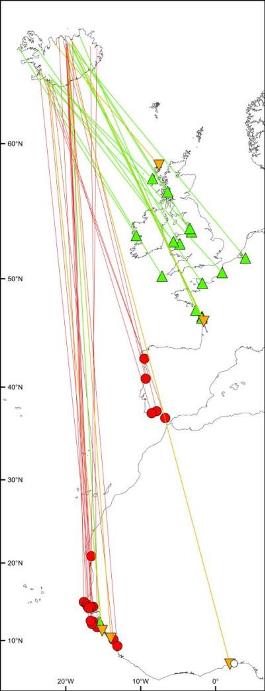 Figure 1 All foreign recoveries and sightings of Icelandic-ringed Whimbrels and ringing sites of foreign-ringed Whimbrels recovered in Iceland. Red dots = winter (1 Oct-31 March); green triangles = spring (1 Apr – 30 Jun); orange triangles = autumn (1 Jul – 30 Sep); white dot = undated. Figure taken from Gunnarsson & Guðmundsson (2016).
Figure 1 All foreign recoveries and sightings of Icelandic-ringed Whimbrels and ringing sites of foreign-ringed Whimbrels recovered in Iceland. Red dots = winter (1 Oct-31 March); green triangles = spring (1 Apr – 30 Jun); orange triangles = autumn (1 Jul – 30 Sep); white dot = undated. Figure taken from Gunnarsson & Guðmundsson (2016).
The distance between Iceland and Banc d’Arguin in Mauritania is ca. >4,800 km, which is considerable for a direct flight but well within the currently described non-stop flights for large waders. In any case, why would Icelandic Whimbrel risk flying over the ocean where there is no shelter if adverse weather conditions are encountered (nor suitable feeding options), particularly when they could stop along the way? It is known that migratory landbirds typically avoid crossing large ecological barriers such as mountain ranges and oceans (Newton, 2008) and often they use routes over suitable habitats where they can stop to rest and refuel during migration. For Icelandic Whimbrels, stopping in Europe would only incur a slight detour of approximately 500 km from the shortest and direct route. Generally, long-distance migratory species do undertake stop-overs during either both journeys, or spring migration only. This is particularly relevant for birds breeding at high latitudes, as spring stop-over allows them to gauge conditions closer to the Arctic and subarctic breeding grounds, given that arriving too early may also be disadvantageous if conditions are unsuitable upon arrival (everything might still be frozen!). Additionally, by making a stop-over, migrants can refuel and restore their body reserves, thus increasing the chances of finishing the last leg of their journey and arrive in good conditions. Therefore, non-stop long distance flights over the ocean may jeopardise their survival as both no sheltering options are available and weather conditions in distant locations at future times are impossible to predict (Shamoun-Baranes et al., 2010).
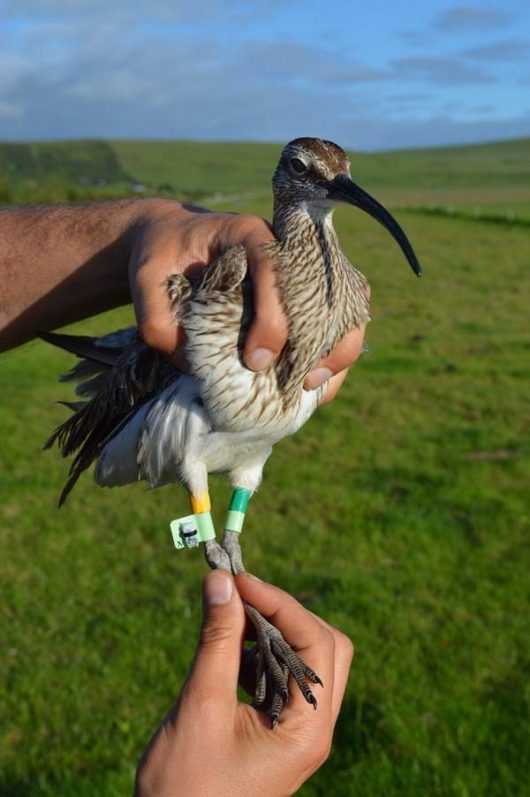
In order to figure out if Icelandic Whimbrels were indeed “gamblers” risking all on long direct flights between Iceland and West Africa and back, we deployed geolocator tags attached to a flag on 10 Whimbrels in the summer of 2012 (Fig.2). Seven came back to their breeding territory, and we were able to retrieve five geolocators, four of which contained the long awaited answers to our questions. And a bit to our surprise, the tracking confirmed that Icelandic Whimbrel do indeed make direct flights between Iceland and West Africa on both autumn and spring, with some individuals undertaking a full migration cycle in only two single flights. During autumn migration in 2012, all four Whimbrels flew non-stop to West Africa (Fig.3) covering distances of ~4000 to 5500 km in 5 days. On the return journey, two strategies arise: one involving a stop-over (as previously recorded with recovery and count data), and another one involving a direct flight- a strategy that is new for species that have an alternative and mostly overland route available. During Spring, two Whimbrels stopped for 11 and 15 days in Ireland, covering a distance of ~10,500 and 11,000 km respectively, whereas the remaining two flew directly to Iceland, for a total round trip of ~7800 and 11,000 km (Fig. 3).
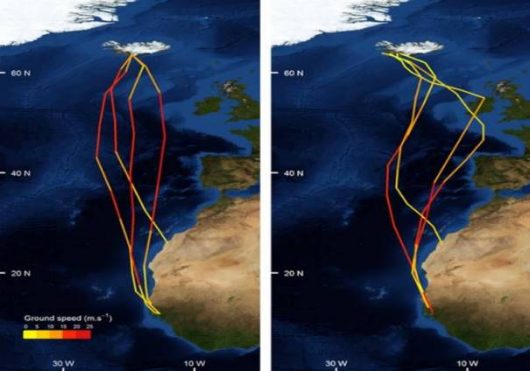
Given these impressive flights we were also interested in understanding how wind conditions could either help or hinder Whimbrel long migratory flights. We found that in autumn, all Whimbrels departed Iceland in favourable wind conditions, but all arrived to West Africa facing headwinds, which mostly occurred during the last part of their trip. But the story was slightly different at departure from West Africa, where only one Whimbrel left with favourable wind conditions, and all others departed in headwinds. This suggest that time pressure is most likely in operation in this system with Whimbrels taking flight even when conditions are not ideal. Furthermore, despite all Whimbrels departing West Africa at similar times (22nd-29th of April), those individuals stopping over experienced overall slower migration speed than those flying non-stop (which includes the first and last individuals leaving Africa), which arrived 6 to 10 days before the Whimbrels that stopped. In other Icelandic breeding waders such as the Icelandic Black-tailed Godwit Limosa limosa islandica, individuals that arrive earlier have higher breeding success as they occupy higher quality territories and nest earlier (Gunnarsson et al., 2005). However, we did not find differences on laying dates between Whimbrels that flew non-stop and those that made a stopover, so and despite the small sample size, it seems that other factors such as environmental conditions for nesting or mate arrival time might determine the timing of breeding on this population.
If you enjoyed this story and would like to know more about Whimbrels, their migratory strategies and carry-over effects, Camilo Carneiro will present some of his PhD work with this species at the forthcoming BOU’s 2017 annual BOU conference. Hopefully see you all there!
References
Gunnarsson T.G., Gill J., Newton J., Potts P.M. and Sutherland W.J. 2005. Seasonal matching of habitat quality and fitness in a migratory bird. Proceedings of the Royal Society B: Biological Sciences 272: 2319–2323. VIEW
Gunnarsson T.G. and Guðmundsson G. 2016. Migration and non-breeding distribution of Icelandic Whimbrels Numenius phaeopus islandicus as revealed by ringing recoveries. Wader Study 123: 44–48. VIEW
Newton I. 2008. The migration ecology of birds. Academic Press, London.VIEW
Shamoun-Baranes J., Leyrer J., van Loon E., Bocher P., Robin F., Meunier F. and Piersma T. 2010. Stochastic atmospheric assistance and the use of emergency staging sites by migrants. Proceedings of the Royal Society B: Biological Sciences 277: 1505–1511. VIEW
Image credit
Featured image: Icelandic Whimbrel Numenius phaeopus islandicus © Tómas G. Gunnarson
If you want to write about your research in #theBOUblog, then please see here.


